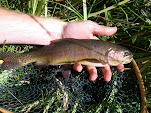Fall on the Puget Sound is a special time, with Coastal Cutthroat at their grabbiest, migratory salmon returning and the best saltwater dry fly fishing of the year. This dry fly action all revolves around the annual emergence of termites from the driftwood that liters the Puget Sound's shoreline.
 |
| The forgotten hatch |
 |
| The fly |
When things come together with this hatch you can get both sea-run Cutthroat and resident Coho Salmon going nuts feeding on these big insects on the surface. The dead drift works great, but twitching or skating flies also works and will get some great extremely aggressive takes. Some of the key ingredients to this hatch though include timing, weather and tide.
The other day I made it out in hopes that I could put the pieces together and the Cutthroat would be looking up. I got the timing factor right, it was about two hours before dark when the termites start to fly, and flying they were. I got half of the weather right, termites are most likely to emerge from the driftwood on sunny evenings, but a slight breeze helps to knock a few of the weak fliers into the water for the waiting trout. This evening though the water was glass.
 |
| Termites were a flying |
The other factor, probably the most important one out of the bunch was the tide and that was the one that didn't line up. High slack water... Not so ideal and as such it just ended up being a beautiful evening to practice some casting on the beach.
 |
| A great time to be on the water |
This is not the end of the story though, with the stars not aligning for me, as I decided to give things another go in the morning with my buddy Colton. The tides were much more ideal, even if it wasn't dry fly time. So I put on my favorite subsurface attractor pattern and gave things a go. The first hour was especially slow, then I noticed a couple of fish jump just down the beach from and things began to change. Within a few casts I hooked a fish that came in quickly and ended up being a little 8" resident Coho. This fish was by far outclassed by my 6wt rod, but makes for a great sign for this next season's salmon fishery.
The very next cast I hooked another fish, but this time the odds flipped around on me and it was my 6wt that was outclassed. After a few nips the fish slammed my fly and I was locked into battle with a 7lb migratory Coho. However, good things rarely last long and this was one battle I wasn't going to win. The fish immediately did an under the water roll then charged me, ending the battle with a leap out of the water 10 feet off of my rod tip and launching my fly right back at me. To say the least I was a bit disappointed after this loss, this is the fifth Coho I have locked into and lost this year on the salt and was by far the largest. As this is just the beginning of the season and hopefully this is just a sign that things are picking up. That was at least what I had to keep telling myself as I tried to keep my head on straight and kept casting. And what do you know it, this thinking was rewarded! It wasn't another big Coho, but instead the fish that I had come here to target a beautiful 14" heavily spotted Cutthroat. After that fish though, things once again slowed down and it was time to get of the beach.
 |
| A beautiful consolation prize Cutthroat |
At the moment, I just arrived in Wyoming so the next report will be from Yellowstone and the Tetons. Hopefully the Cutthroat over here will be willing to bite and help keep my mind off those big Coho until I get back!




































